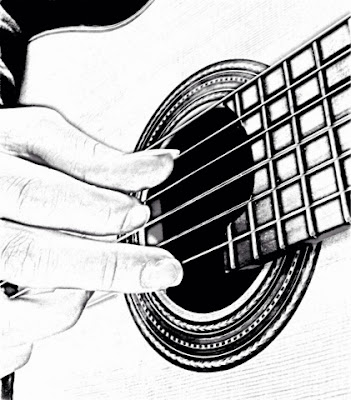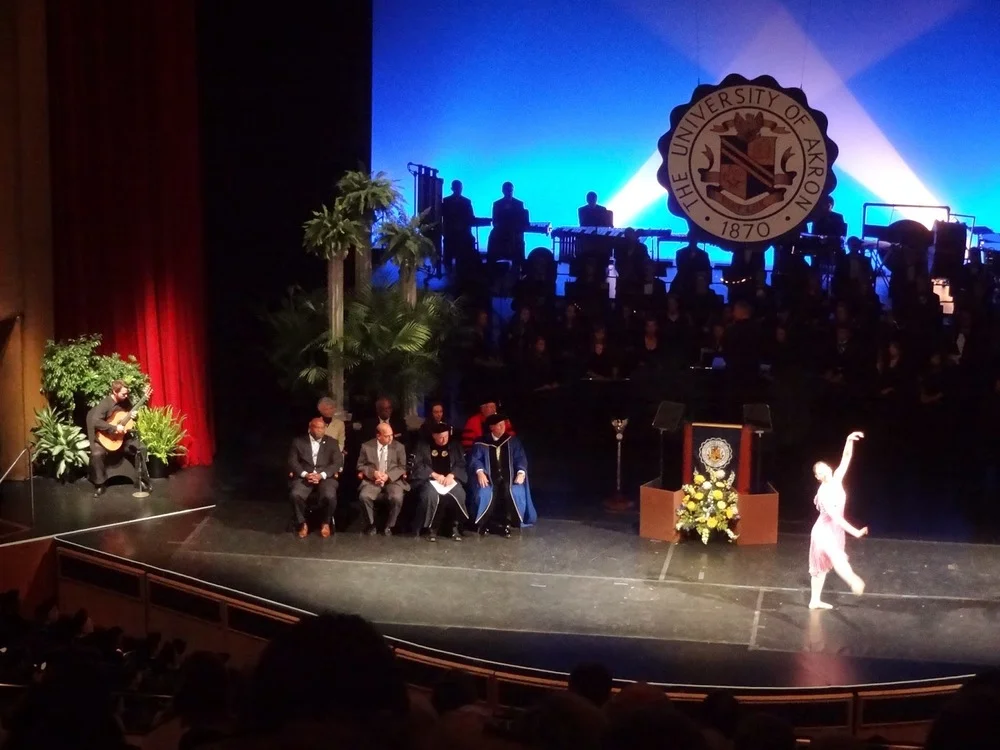I've asserted that tone is the reason we are drawn to the classical guitar so many times it's become like a trope. But that doesn't mean it isn't true. If you ask non-players what they like about our instrument, they inevitably refer to it's unique sound, it's tone. They might describe it as intimate, sweet, velvety, smooth, singing, even sensuous.
Of course, we know well how many sounds we can get out of the instrument, and many of them are anything but sweet. Still, this core sound, our fundamental neutral sound, is generally a sweet one, with brighter, harsher sounds being deviations from that norm, and used mostly for emphasis or variety.
In my teaching, I have always held that
tone
is first--that it is hard to produce beautiful sound with bad technique. That from this foundation, all else will come easily.
So we work at it. There are excersises to drill. There is nail shape and length, string quality, volume. We do lots of listening, always assessing quality of sound as a key element, so clear and purposeful modeling can take place. In this way, my studios have developed a reputation for students whose tone is reliably beautiful.
In this post, I'll share these concepts and excersises, and hopefully help some whose tone concept isn't yet fully formed.
In this discussion, I refer to great tone as that thick, fat, warm sound only the classical guitar can make. Other tones, thin ones and harsh ones, are terrific but I regard as deviations from a universally desirable, dolce neutral.
First, it is important to understand the basic mechanics of sound production. It is helpful to think about free stroke (tirando) and rest stroke (apoyando). Generally, players can increase both the volume and the quality of the sound by playing a rest stroke, hence its preference in louder melodic passages. Why is this? The reason goes to the fundamental mechanism of the vibrating top: the more and wider the top vibrates, the louder and fuller the sound. How to make it vibrate more? Push the string in the direction of the vibration.
The top moves in one
direction
only: up and down (see illustration). The simplest way we have to push it in that direction is by pressing down on the string, thus the rest stroke. The way to get this effect in a free stroke is by using a subtle combination of nail shape and angle of stroke. It is this little bit of magic the guitarist must master. I
n inexperienced hands, free strokes tend to draw the string side-to-side, in a direction parallel to the face of the instrument, and so fail to generate much energy in the top, resulting in a thinner, quieter sound.

If the nail is shaped in a simple crescent, following the curvature of the fingertip, the effect is straightforward to produce. With the wrist straight, the fingertip touches the string on the left side first (as you look at the back of the hand). As the nail is drawn through the string, directly in alignment with the wrist, the nail will push the string in, towards the face of the instrument as it releases the string. If the nail edge is perfectly rounded and polished smooth, the sound will be the full, round tone desired.
Note that a straight wrist produces the desired nail angle. The impulse to turn the wrist and produce the sound with the nail straight across the string should be resisted. (The nail is straight against the string when both the left and right sides of the nail are in contact with the string as the note is played). Focus on the leading edge, the left corner of the nail touching first and drawing through firmly, holding the angle steady.
If done correctly, this stroke will push the string in towards the face of the instrument slightly as the note is produced, exciting the the top and resulting in a big, warm sound.

Hand of Jeremy Avalos
It is critical to always play from exactly the same location on the fingertip/nail. Think of it as
The Spot
. The role of the flesh in sound production is to mute the potential clicking sound at the moment of contact. That's it. The
nail
makes the musical tone. If when practicing (and playing in general) you always (always!) play from exactly the same Spot on the nail, backed up by the same spot on the fingertip, your tone will be much more reliable and consistent. Work for precision in the contact point: look for The Spot. Once this process is fully internalized and your tone is reliable, then experimenting with others tones and articulations will be more productive.
It is also critical that the nail edge is polished smooth, I am always amazed when students show up to lessons with nails that aren't ready. (They want to use their lesson time to prepare them?) I prefer the Silicon Carbide 500 grit open-coat sandpaper for refining the edge. (And a jewel file to adjust length and shape). This product, still one of the best deals around, is available from stringsbymail.com or GSPGuitar.com. Even after the whitish original grit is rubbed off, this paper has plenty of polishing power. Before playing each day, be sure the nails are perfectly shaped and polished.
A great way to practice for great tone was offered to me as a student by University of Arizona prof., Tom Patterson. I've been using it and variants of it with my own students ever since. Play a series of four open g's, as prepared 8th-notes, followed by 8th-note rests (the rests created by the preparation of the following finger). Play the sequence i-m-a-m. Do it three times as follows:
The first time, the notes are "shallow rest strokes"-that is, land on the adjacent string at the nail rather than deep into the finger tip. Aim for the biggest, fattest, most beautiful and robust sound you can produce.
The second time, allow the stroke to carry right through the adjacent string, producing the double-stop of g/d. The finger will not touch the fifth string, but instead will feel like a deep free stroke which articulates two strings, nearly at once. Aim to produce the identical volume and tone you produced when playing the first four notes.
The third time, permit your nail to miss the 4th string. Keep all angles and positions as similar to before as possible. This will be a free stroke, but played from the same hand/arm position as the rest strokes were. If you accidentally brush the adjacent string, it is ok, as the lower the trajectory of the fingertip, the better. Aim to once again match tone and volume with the previously played notes.
Repeat the twelve notes on every fret of the third string, both up and down. That's it.

The goal is to harness the sensation, physical characteristics and volume/tone of a rest stroke and transfer them to a free stroke. I recommend doing this as described, then repeat the exercise on the second string. On alternate days, repeat it on the first string, so that each day, it is done twice--once on the third string and once on either the first or the second string.
Most of the notes we play are free strokes. If we only have great sound on, say, the 10-15% of notes we play using rest stroke, we won't have very good sound! We need fabulous free strokes. I encourage my students to start EVERY day with this exercise, and many do just that. It is a slow, relaxing, activity that helps focus on sound, pure and simple. It also allows time to concentrate on finding The Spot, and to check your posture and the general positions of both hands. It is a healthy way to begin a day of practice and one that yeilds big returns for what feels like modest effort.
Try it.



